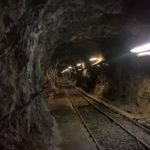If the hematite mines of Rio Marina (Elba island ) have an ancient history, that started in the Etruscan Era, almost 2500 years ago, the magnetite ones, situated near the sea in the municipality of Capoliveri, only started their activity in the last century, to then close permanently in 1981. Of this huge mine, which was the biggest in Europe, only a third of its total capacity was exploited. The motives for which it was closed were mainly two. For Italsider, the company who had the concession of the mine, this choice depended mainly on economic reasons: it was cheaper to buy the mineral in countries where the cost of labour was lower than in Italy. For the state it was considered necessary to conserve a large stock of raw material in forecast of eventual times of difficulty to maintain a supply (for example sanctions, or a sudden rise in price of minerals coming from abroad).
In contrast to other mines which, especially in the bigger areas, after the mine was abandoned, most of it collapsed due to the instability and softness of the rock, the Capo Calamita one, developing mostly inside a mass of extremely compact magnetite, does not have any risk of rockfall and, since the day it was abandoned up until today, has stayed intact, therefore suitable to be equipped for guided tours for tourists.
From Capoliveri a panoramic route is taken, partly dirt track, that in about six kilometres leads to the building which hosts, apart from the ticket office, a small mineral shop and a museum illustrating visitors the aspects and equipment of the day to day life of the miners.
From the ticket office, with a minibus belonging to the company that runs the tours you go down to the entrance of the mine, situated near the sea in a particularly charming place where the imposing metal structures can be seen testifying the intense workload that went on in the mine in a recent past.
The a two possibilities of tours, not combined, both lasting about fifty minutes. The first, covers a perfectly horizontal route along which equipment and rooms can be seen which give quite a clear idea about the work went on inside the galleries. Along the route you look onto two huge shafts 65 metres deep which correspond to the same amount of nucleus of magnetite. In the second shaft rockfall dating back to a few years ago has caused the diaphragm which separated it from outside to fall down, allowing rays of sunlight to penetrate into the underground with a very spectacular scenic effect.
The second involves going down a difference in level of about thirty metres which brings visitors to 24 metres below sea level in an area maintained constantly dry by a system of pumps which prevent the natural rising of the water table.
The guides are very good in describing the daily life that miners spent underground and are able to transmit to visitors an emotional experience.
The complex system of opening days and times varies from year to year, therefore before leaving, it is always better to phone one of the numbers which can be found on the website www.minieredicalamita.it.
- Questa discenderia porta a 24 metri sotto il livello del mare. This mine shaft goes down for 24 metres below sea level.
- Un raggio di sole penetra nella miniera attraverso lo sfondamento della volta. A sunbeam through the collapsed ceiling.










